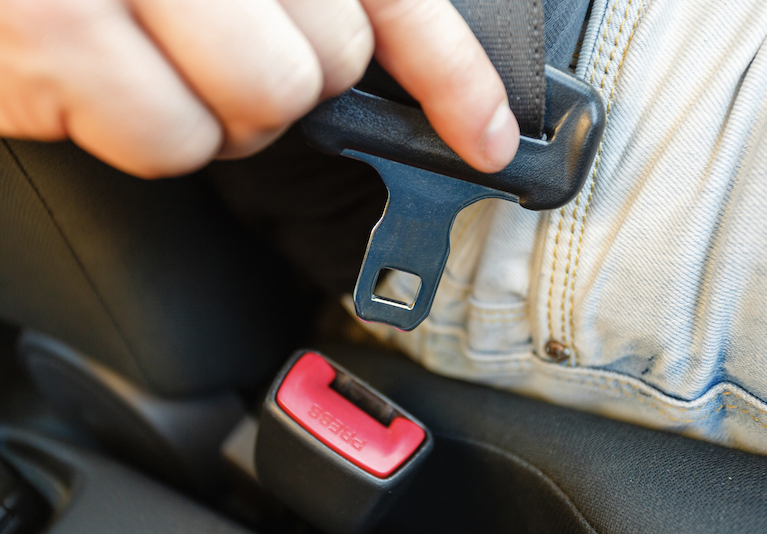It has been law since January 1983 for all drivers to wear a seatbelt, and if you refuse to wear one, it can land you in trouble legally, not to mention the risks you’re taking with your safety. It has been since 1965 that manufacturers had to install seatbelts in vehicles, but it took another 18 years for this to become a driving law.
Since the introduction of the seatbelt law, it has massively reduced the number of deaths on the roads as previously, over 50% of fatalities were due to the fact they were driving unrestrained or were hit by a passenger that was not belted. It’s frightening to think that an unrestrained object, person or even a dog can lead to the death of the front passenger and drivers due to the speed and impact of a crash.
Seatbelt exemptions
There are a few legal exemptions from wearing a seatbelt, allowing you to un-hook the seatbelt if you are reversing a vehicle or supervising a learner driver while reversing. If you are a delivery driver less than 50 metres between drops or a taxi or private hire driver plying for business. You are also exempt if you are investigating a fault in a trade vehicle as a passenger. These are the only exemptions allowed unless there is a medical exemption certificate or if the vehicle you are driving does not have seat belts.
Medical exemptions
There are many reasons that you can be medically exempt from wearing a seat belt, but this must be accompanied by a Certificate of Exemption from Compulsory Seat Belt Wearing issued by your GP. This form must be kept in the car at all times to show the police if necessary, and you must also inform your insurance company. If you have had recent chest or abdominal surgery, your doctor can likely issue a temporary exemption certificate while you are still healing. Every exemption certificate is given on the driver’s individual needs, and pregnancy is not necessarily a reason to be given an exemption certificate.
Being registered as disabled does not automatically allow you to be seatbelt exempt in a car as a passenger or driver unless there is a good reason. Many disabled drivers use gadgets such as ‘Drop Links’ that move the diagonal position of the belt. These are great if the person is of restricted height, and a conventional belt would cross the driver’s neck. ‘Pulla’ belts are beneficial if stretching to pull a seatbelt is difficult, and the ‘Klunk Klip’ belt is designed to put less pressure on the waist and is used for those with lower abdomen problems or using a colostomy bag. Your GP will advise on these before offering a medical exemption as they have to weigh all the pros and cons of letting you travel unrestricted by seatbelts. An accident without a seatbelt can far outweigh the reasons for wanting the exemption.

Child passengers and seatbelts
Children under the age of 12, or a minimum of 1.3m in height, must always use a booster seat and a seatbelt once they have outgrown the height and weight-based baby and toddler seats. Once they are over 12 years or taller than 1.3 m, they can travel as passengers with fitted belts.
Under the age of 15 months, a child must be secured in a rear-facing car seat, and it must be fitted with ISOFIX points or designed to be used with diagonal belts. If the seat is to be used in the front passenger seat, the airbag must be deactivated.
You cannot legally attach a child car seat to a side-facing seat within a larger vehicle.
There are a few exemptions for a child not wearing a belt or in a car seat, whether in a taxi, a minibus, a coach without fitted belts, or in an emergency. Every attempt to secure the child must be made, and over the age of 3 years will mean they can use the fitted seatbelts to a certain degree. Children under 3 years old cannot be transported without a car seat unless in a minicab or on the rear seats, but these are for emergencies only.
Disabled children can be given an exemption certificate from the GP, but they can use seatbelts or child restraints designed for their specific needs.
Vehicles without seatbelts
You can legally drive if you own a classic car initially built without seatbelts. Still, you must not carry any children under the age of 3 and then only be allowed to travel in rear seats, so if you have, for example, a small 2-seater classic car, you will not be allowed to carry a child at all.
Seatbelts and the Law
There is a fine of up to £500 if caught not using a seatbelt without good reason, and the same penalties carry if caught with a child under the age of 14, not sitting in the correct car seat or wearing a seatbelt while you are driving.

